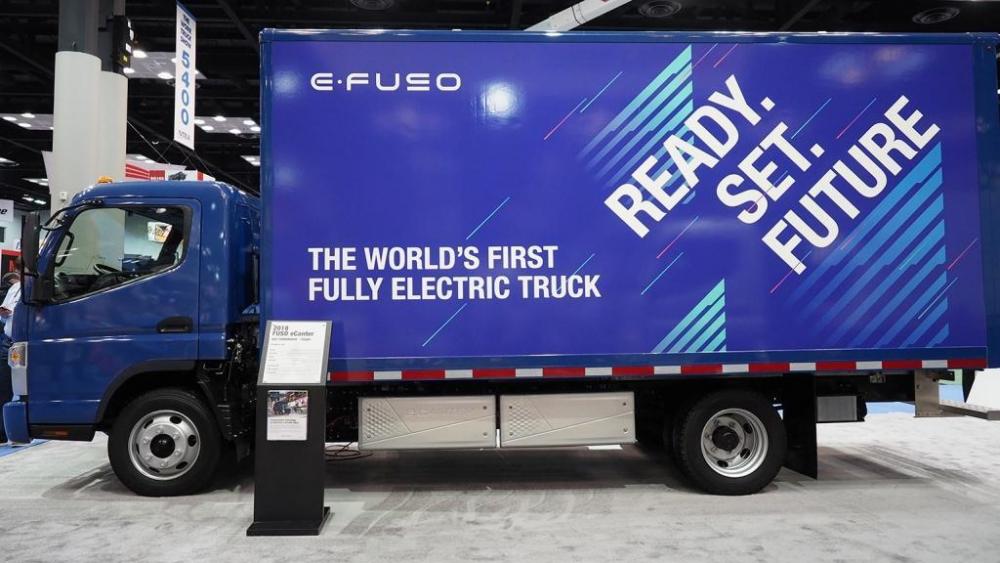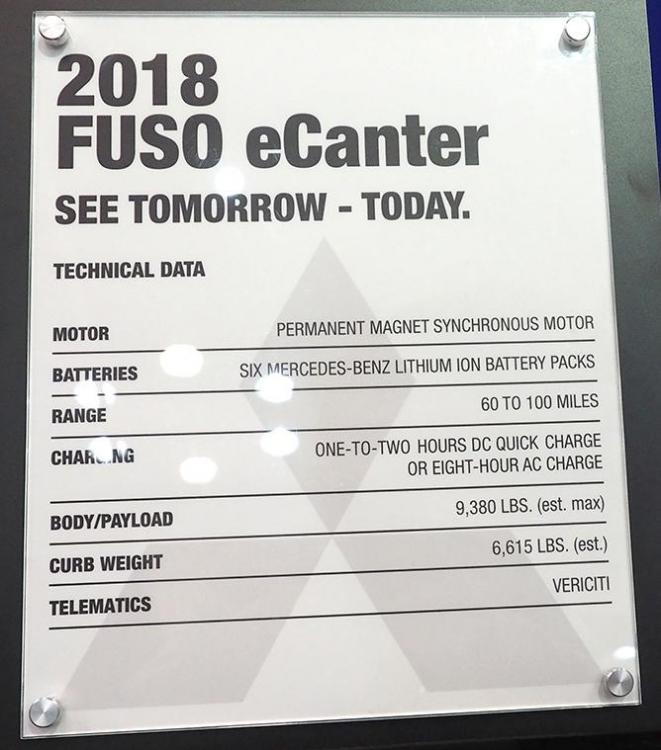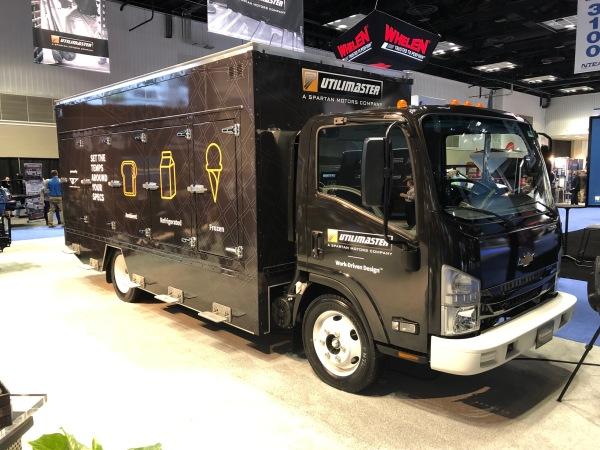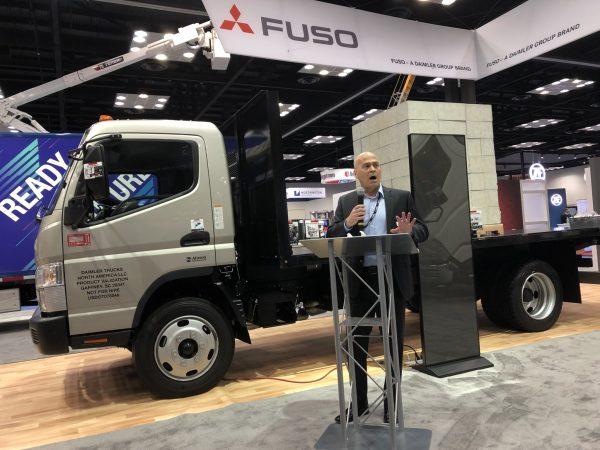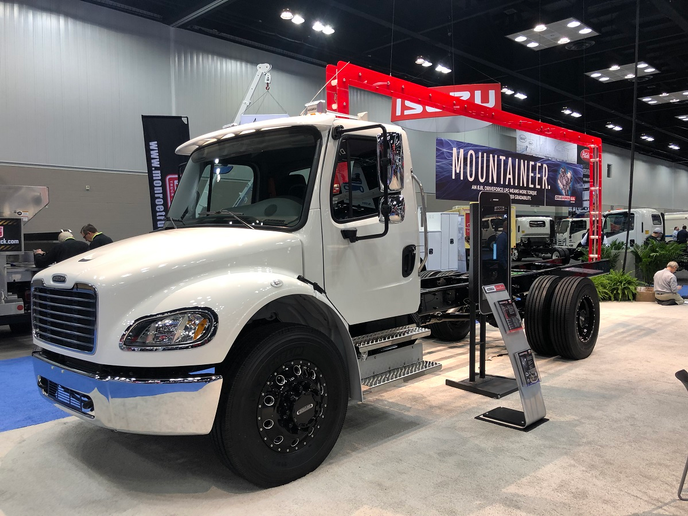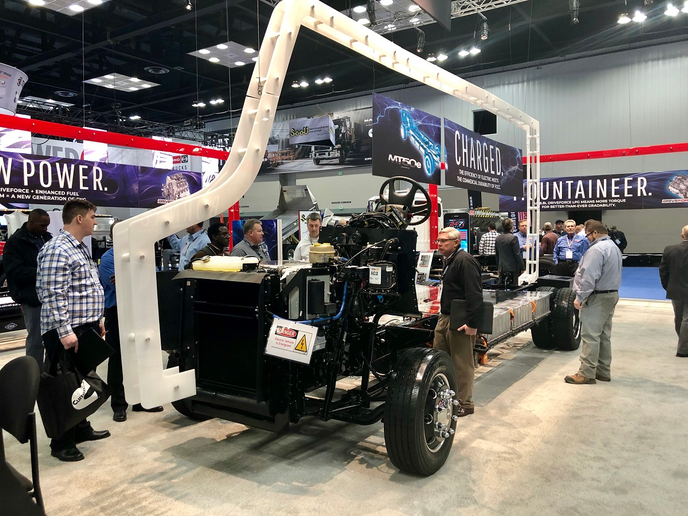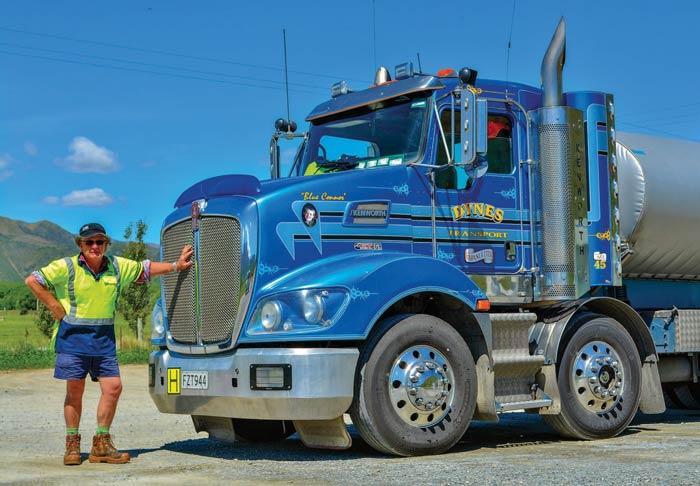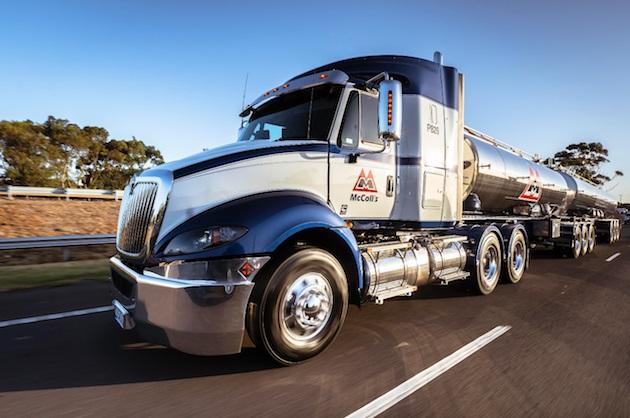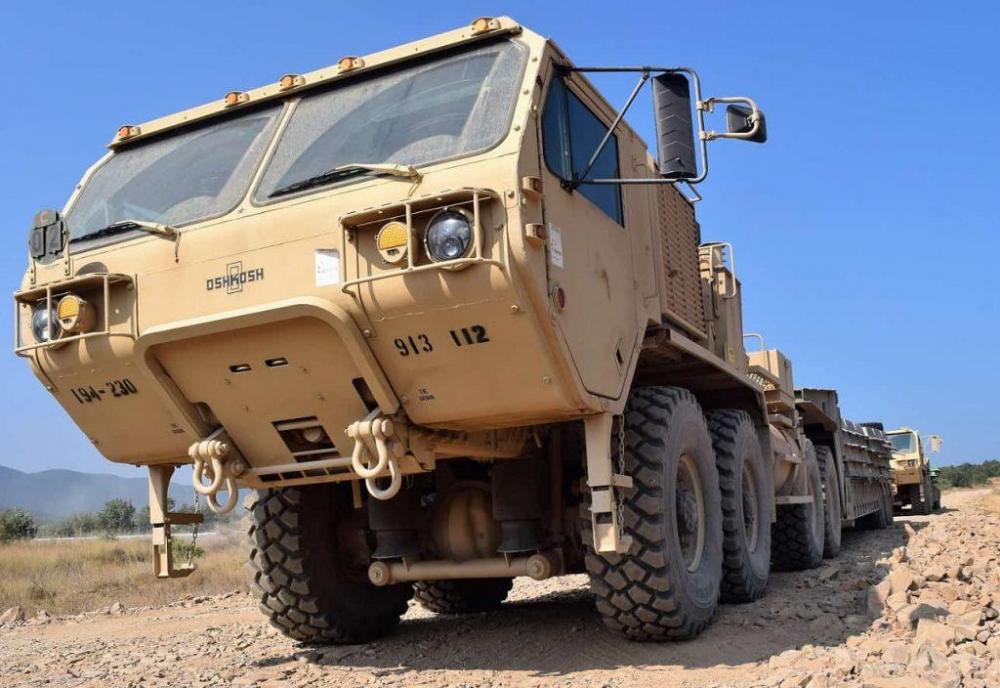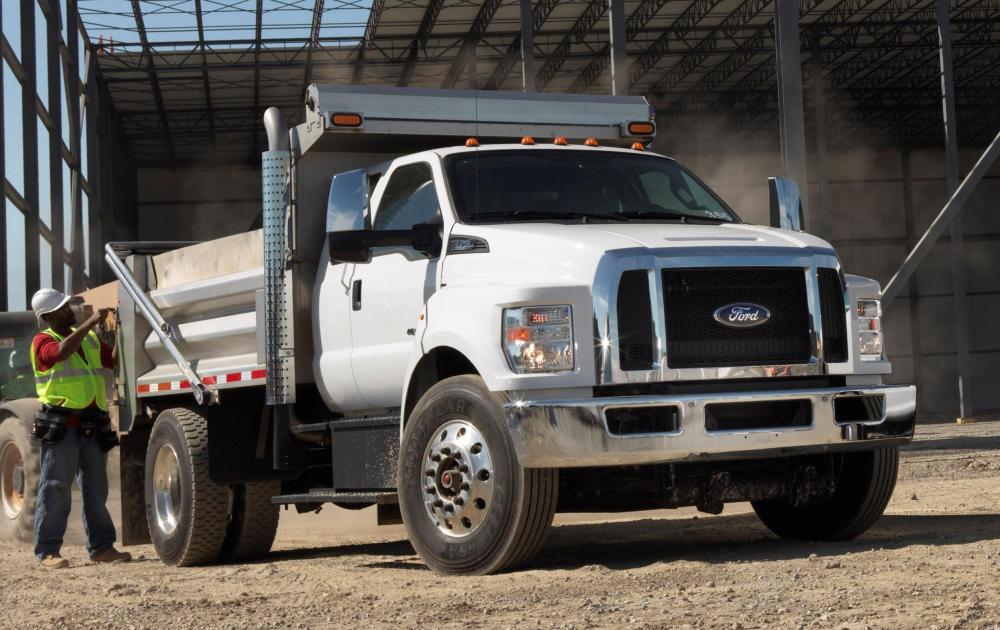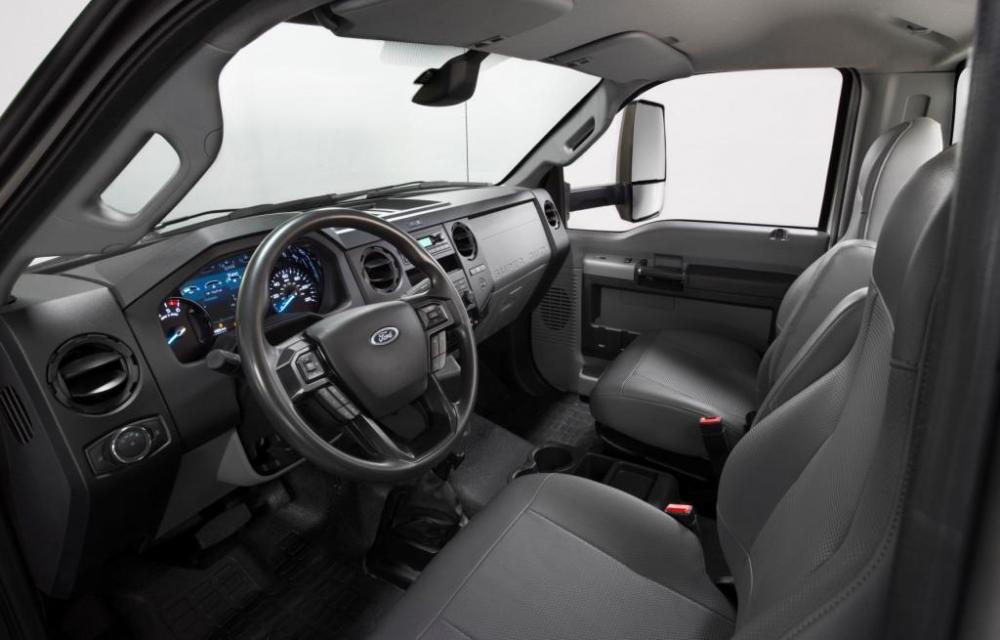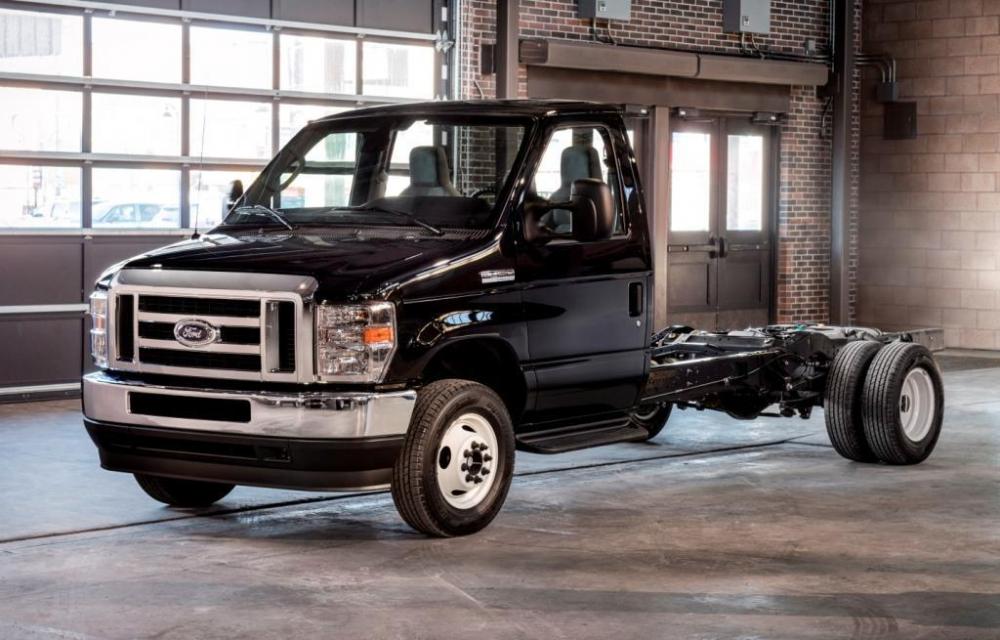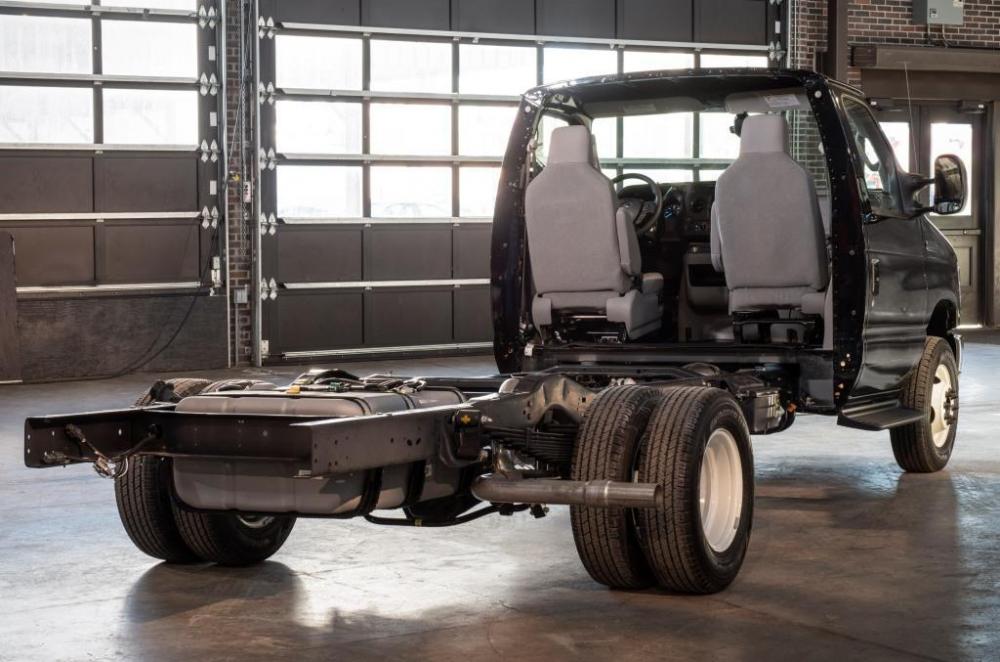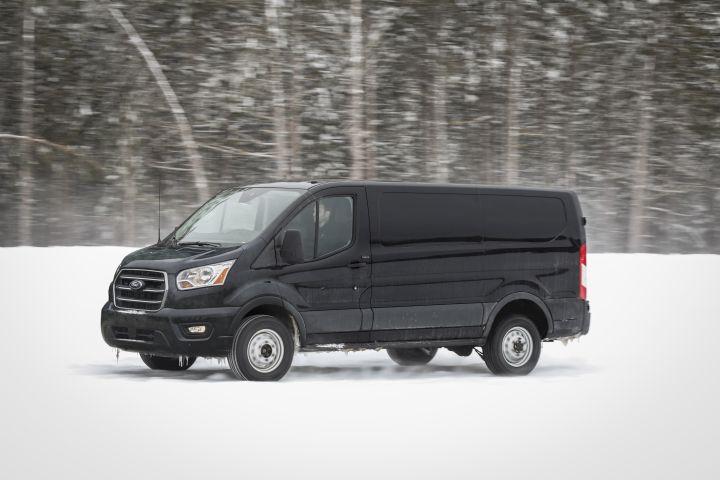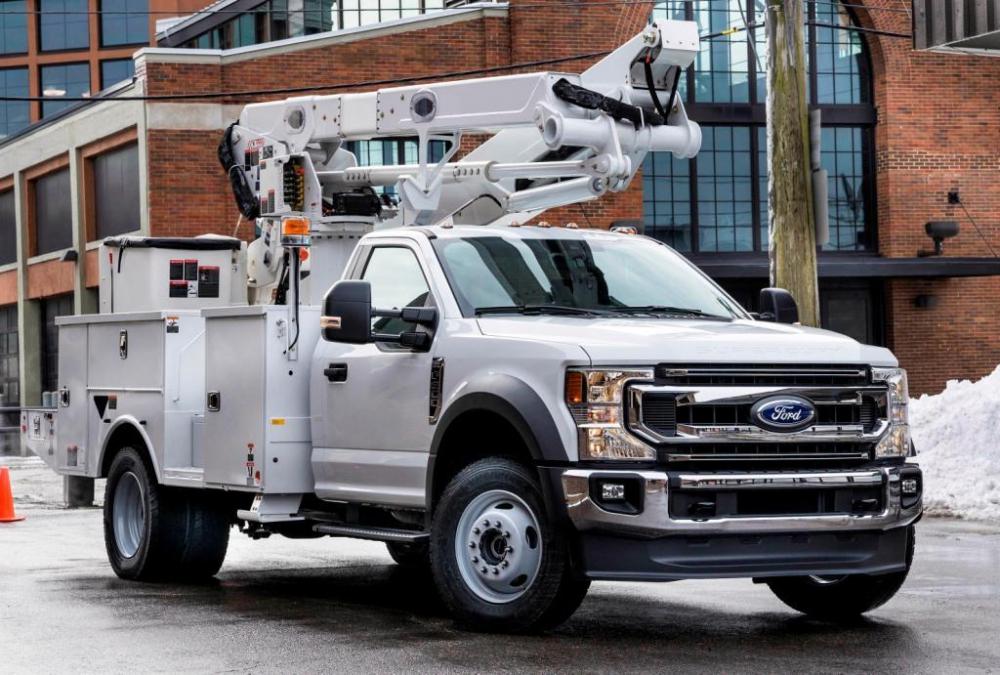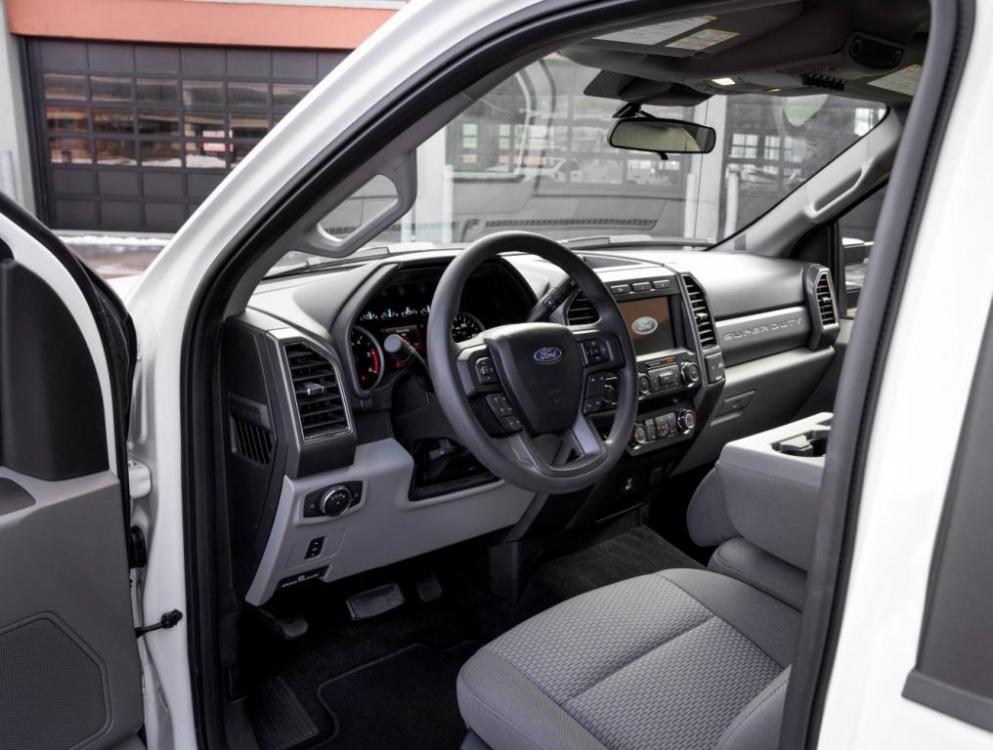
kscarbel2
Moderator-
Posts
18,854 -
Joined
-
Days Won
114
Content Type
Profiles
Forums
Gallery
Events
Blogs
BMT Wiki
Collections
Store
Everything posted by kscarbel2
-
Aaron Marsh, Fleet Owner / March 7, 2019 INDIANAPOLIS. At the NTEA Work Truck Show in 2016, diesel and gas prices had dropped dramatically and interest in alternative fuels in trucking seemed to have followed suit. An oddball among truck and product launches at the show that year was Mitsubishi Fuso's battery-electric prototype of its Canter cabover truck, and when the OEM called it "the future" for such vehicles it seemed a stretch at best — or maybe just out of touch with reality. Thirty-six months later, nearly every existing truck manufacturer and a number of new players besides are working on, testing and investing in their own electric trucks spanning Classes 1-8. Meanwhile, Fuso's Class 4 battery electric eCanter went into series production for the U.S. market last year, the company expects to reach full commercial production in 2019, and work is well underway on a model update. "This is the fourth time that Fuso is showing an e-propulsion truck at the NTEA," said Justin Palmer, president and CEO of Mitsubishi-Fuso Truck, at a press event Wednesday at Work Truck Show 2019. "Three years ago, when we came with our E-Cell — the first version of the electric truck — everyone was shocked. Everyone was joking. And everyone was asking, 'What is Fuso doing?'" "Today, go around the floor — everyone's trying to do the same," he continued. "Everyone is trying to do what we started doing some time ago." It's no overstatement. As alternative fuels to diesel in trucking go, the greatest interest and momentum is clearly now in electric power and propulsion. Electric trucks are not only the biggest crowd-draw and item of interest among fleets and trucking companies — for reasons ranging from business to environmental benefits — they've transitioned from essentially a shiny show trinket to a dominant theme for a truck development race every OEM wants to win. For now, Fuso's eCanter is designed for short-distance trucking jobs such as urban distribution and pickup-and-delivery operations. Bill Lyons, Fuso's vice president of sales operations, acknowledged that the current model works well but has its limitations, and "Version 2.0" — for which he wouldn't give a release date — will bring improvements. The eCanter "is really designed for the urban market, so it does very well there. It's not an over-the-road truck," Lyons said. "The way [customers] run their operations, from the charging to route optimization, they're having great success. "It's very quiet, and it actually has a lot of torque off the start," he continued. "Customers give us great feedback on this truck, and we'll continue to learn. Obviously, down the road, we see more opportunities for the technology to change so the range can get better and things like that. That's what we're learning today." Fuso made another propulsion prediction for where the market is going in its segment of medium-duty Class 3-5 cabover trucks as the company rolled out a heavier-class gasoline-powered cabover, the Class 5 FE180 Gas. It features a General Motors 6.0L V8 rated at 297 hp and 361 lbs.-ft. of torque paired with an Allison 1000 Series automatic transmission. Like the lighter Class 4 FE Gas cabovers Fuso debuted last year at the Work Truck Show, the FE180 Gas will come with a number of standard features and benefits including electro-coated frame rails for added durability, a 40-gallon in-rail fuel tank, 19.5-in. tires, keyless entry, and a year's subscription to Verizon Connect telematics services. Fuso said in a release that it "developed this new truck with the understanding that gasoline-powered trucks are shifting the industry norm from diesel to the new standard of gas." "Why are we doing it? Because we identified that the customers want gasoline and we see our competition — we see other players — going in the same direction," Palmer contended. "And I have to say that I feel very comfortable as an underdog in many ways to lead the market, both in the gasoline segment and definitely in the electric segment, and proud of it. "I think it shows that we're going in the right direction," he said. The FE180 Gas is expected to arrive at dealerships late this year as a 2020 model and will be built at Daimler Truck's Freightliner Custom Chassis Corp. plant in Gaffney, SC. Lyons said Fuso is seeing customers such as landscapers, plumbers, electricians and other tradesmen choose its gasoline-powered trucks over diesel models, noting the complexity and operating costs of diesel trucks is helping drive these buyers away. For instance, gasoline engines don't have the same complex emission-control systems diesels do or require diesel exhaust fluid. "Those kinds of things make it difficult for a regular user," Lyons said. Fuso is emphasizing that the FE180 Gas and its other gasoline-powered models can simplify things; here at the show, one of the tag lines the company is using for the FE180 Gas is "Fuel it like a car, work it like a truck." "You start reducing the complication and the price of fuel — gasoline is cheaper than diesel — and in the right operations, [a gasoline-powered truck] actually has more uptime," Lyons contended. "The truck is on the road a lot more, and that's what the customer is telling us." .
-
Freightliner to Display Battery-Electric eM2 Model
kscarbel2 replied to kscarbel2's topic in Trucking News
All the Daimler group trucks are sharing electric propulsion system technology. -
We never sold many 2 over rod and main bearings. They dealt with original production minor imperfections. You may have to turn your crank to over 10.....you can still get that main bearing kit.....215SB72DP2.
-
Freightliner to Display Battery-Electric eM2 Model
kscarbel2 replied to kscarbel2's topic in Trucking News
. -
John G. Smith, Truck News / March 6, 2019 INDIANAPOLIS, Indiana – Spartan Fleet Vehicles and Services’ Utilimaster brand introduced a trio of new vehicle platforms at the annual Work Truck Show – a pair of electric designs, and a body specifically developed for increasingly popular last-mile grocery deliveries. A walk-in van developed alongside Motive Power Systems is charged by lithium-ion batteries and promises the same performance as a traditional-fuel-equivalent vehicle, complete with an 85% reduction in operating costs and 66% reduction in maintenance costs over the life of the vehicle. The second electrified chassis developed in a collaboration with Cummins was designed for the parcel delivery market. Like the Utilimaster Reach, this unit is built on Isuzu’s strip chassis, with a powertrain delivering a 135-km range using three BMW batteries, 3,200-lb. payload, and a charging time of less than six hours. The range jumps to 190 km between charges with four batteries. Packaged in a Class 3 platform with a 22,000-lb. gross vehicle weight, related tests have been ongoing since last October, and production is scheduled for this summer. A last-mile grocery delivery vehicle, meanwhile, includes a temperature-controlled truck body with a cargo area that can be divided for refrigerated, frozen, and ambient temperature goods. North America’s grocery delivery segment is expected to be worth about US $100 billion by 2025, adds Daryl Adams, president and chief executive officer. “There is a need out there.” .
-
As has been said, the new truck might in fact be a Class 7/baby 8 replacement for the sale failure Granite MHD, and not a mainstream Class 6 medium at all.
-
Introducing the new GM 6.0 V8-powered FUSO FE gasoline truck
kscarbel2 replied to kscarbel2's topic in Trucking News
Fuso going with gas in Class 5 cabover John G. Smith, Truck News / March 6, 2019 INDIANAPOLIS, Indiana – Mitsubishi Fuso Truck of America is building on its commitment to gasoline engines with the first gasoline-powered Class 5 cabover in the marketplace — the FE 180 Gas. “Customers want gasoline and we see our competition, we see other players, going in the same direction,” says president and CEO Justin Palmer. The 2020 Model Year truck comes with a GM 6.0 L V8 that delivers 297 hp and 361 lb-ft of torque. That is coupled to a PTO-capable Allison 1000 Series transmission. Fuso is also including FuelSense 2.0, featuring the DynActive shifting that can boost fuel economy 2-6%. Payload estimates approach 11,885 lb. Other standard features include electro-coated frame rails, 40 US gallon fuel tanks, and 19.5-inch tires rather than the 17.5-inch rubber used in other international markets. The cab interior includes an upgraded driver’s seat with more lumbar support, black fabric, and a shifter mounted on the dash rather than the floor. Red seatbelts, cruise control, and power windows are also included as standard features. The manufacturer launched its gasoline strategy in 2017, unveiling the FE140 and FE180 Class 3-5 trucks in 2018. “Gasoline trucks are the new standard for our medium-duty market,” says Bill Lyons, vice-president of sales and operations, referring to particular growth in the Class 3-4 segments. About 60-70% of those trucks run on gasoline. He credits the reduced complexity when compared to diesel. “The drivers who drive our trucks are not really truck drivers in our segment,” he says. There’s no need for them to worry about regens or DEF when driving with this fuel. Fuso now boasts a powertrain lineup with options including diesel, gasoline, and even the electrified eCanter. The latter van has now been released in limited numbers, although the company won’t confirm exactly how many are on the road. “It’s a small number – but very important customers,” Lyons says, referring to lessons being learned. The eCanter has a 16-foot body and range of 95 to 125 km, and can recharge in seven hours using a Level 2 charger, or as little as one to three hours on a fast charge. The manufacturer first showcased an e-propulsion system at the Work Truck Show three years ago. “Today, go around the floor. Everyone is trying to do the same,” Palmer says. The FE180 Gas will arrive in dealerships in the final quarter of this year. . -
Heavy Duty Trucking (HDT) / March 6, 2019 Freightliner Custom Chassis Corporation has added new powertrain options for its chassis lineup including new propane, compressed natural gas and traditional diesel engines. The company’s S2G chassis now comes with two engine options – an 8.0L as well as a new 8.8L from FCCC’s DriveForce lineup of non-diesel engines. New for 2019, the DriveForce 8.8L is a factory-installed liquid propane autogas engine that puts out 270 horsepower and 565 lb.-ft. of torque. It features a GVWR of up to 33,000 pounds and is paired with either an Allison 2500RDS or 2550RDS automatic transmission with PTO provision and comes with a 60-gallon LPG fuel tank. FCCC has also added a CNG version of its MT chassis that is powered by a 6.0L V8 offering 308 horsepower and 367 lb.-ft. of torque. DriveForce offers more powertrain options for dealers, OEMs and end-users and is supported and maintained by Freightliner’s nationwide dealer network and 24/7 factory-direct customer service. The company also announced a version of its MT chassis that is powered by a DD5 diesel engine from Detroit. The DD5 offers up to 240 horsepower and up to 660 lb.-ft. of torque. The engine is mated to an Allison 1000-2000 six-speed automatic transmission and features a GVW of up to 30,000 pounds. In addition, the DD5’s integrated engine brake provides improved braking horsepower and extended service brake life - as well as Detroit’s Virtual Technician connectivity, which provides remote diagnostic services and integration with FCCC’s 24/7 factory-direct service and nationwide dealer network. Lastly, FCCC unveiled a version of its OptiView all-digital dash designed specifically for the commercial truck market. OptiView brings the features and benefits of the Mercedes-Benz S-Class luxury sedan’s digital dash to work truck fleets. Initially developed for the luxury RV market, OptiView’s commercial debut offers the work-truck segment a fully integrated safety system with an easy-to-read interface. Drivers now have a user-friendly system offering a number of features designed to increase driver awareness and protection. Features include: Anti-glare display with bright graphics, clear fonts and streamlined menu structure Integrated with a 360-degree, high-resolution camera system capability - eliminating danger zones from all sides of the vehicle Bluetooth mobile connectivity for hands-free-device use and DriveTech Wheel controls Haptic steering wheel and obstacle detection Tire pressure monitoring system Stability control FCCC expects OptiView to be available on select chassis products by the end of 2019. .
-
Heavy Duty Trucking (HDT) / March 6, 2019 Freightliner Custom Chassis Corporation has unveiled an all-electric pilot version of its MT chassis at the NTEA Work Truck Show in Indianapolis. Developed in partnership with Cummins, the MT50e features a fully integrated electric power system. The MT50e is the first planned product in what will eventually be a portfolio of all-electric products geared toward the pick-up and delivery markets that is also compatible across all vocations. Designed for Class 6 walk-in van bodies, the MT50e will be powered by a factory-installed PowerDrive 6000ev drivetrain from Cummins with a range of up to 120 miles and GVWR of up to 23,000 pounds with no reduction in cargo volume capacity. It aligns with the Connected, Assisted, Safety-focused and Electric (CASE) initiative from FCCC’s parent company Daimler Trucks North America that promotes the development of innovative products that combines all of these attributes into a comprehensive package. MT50e Fast Facts: Drive System: Zero-emissions, all-electric Cummins PowerDrive 6000ev Up to 23,000 pounds gross weight Up to 120 miles driving range (equivalent MPG: 30 to 36 MPGe) Full charge in 8 hours with standard SAEJ1772 Level 2 Charger and 2 hours to 80% state of charge (SOC) with optional SAE J1772 CCS-1 DC Fast Charging Power/Torque: 268 hp Peak / 1622 ft-lb Peak Complies with all FMVSS requirements “The new MT50e blends the earth-friendly and efficient performance of an electric vehicle with the undisputed strength and ruggedness that’s made FCCC the most reliable chassis in the market,” said Mike Stark, product manager for commercial chassis for FCCC. “Most importantly, with the addition of MT50e, we can deliver our customers a chassis for almost every fuel type. They know that when they want to pick their power, there is only one choice: Freightliner Custom Chassis.” .
-
Bob, there is one aspect that nobody here or on the BON (Blue Oval News) site has brought up. Ford is promising 16 new electric vehicles within three years, and they surely will be cars, pickups and SUVs. Meanwhile, almost all the light, medium and heavy truckmakers around the world are planning electric versions of their trucks. However does anyone honestly believe that Ford is planning (investing in) an electric F-650/F-750? The current diesel trucks are the last generation. The next generation will by electric, plug-in, micro-turbine or fuel cell powered. For the low mileage customer who chooses the 7.3L gasoline option, an electric F-650/F-750 with acceptable range would be even better in that operating situation. The 2021 Ford mediums are only faintly rehashed versions of the same old truck. Minimal investment. And the 2021 design is supposed to soldier on for how many more years after that? By 2021, the Ford mediums will be beginning to look like dinosaurs, versus the other latest product on the market. The 2021 Ford mediums might prove to be the last.
-
New Zealand Trucking / March 2019 Richard Thomas from Dynes Transport was manning the Omarama ‘pump truck’, pumping milk over into other Dynes Transport and Temuka Transport trucks when Craig Andrews caught up with him just north of the small Mackenzie Country town. Richard was born in Tapanui where he spent a fair chunk of his life painting and decorating for a living. He and his wife Karen moved to Australia in 2002 but moved back to New Zealand in May last year. Richard starting truck driving about 11 years ago in Australia, most of it on road trains, and mainly Kenworth and Mack. He took up a position with Dynes in September last year to help carry milk. The pump truck is a 2011 T408 Kenworth with more than 1.7 million kilometres on it now. “She’s a bit of a rough riding thing,” says Richard. But every day there is something different to see for Richard and he enjoys the scenery that this part of the world offers him. “Plenty of fresh air and sunshine.” He struggles to find a negative but believes some of our infrastructure could be better, saying it’s not that user-friendly sometimes. Once his day was finished in Omarama, he then took a load of milk back to Clandeboye. .
-
Isuzu Trucks Australia / March 4, 2019 . .
-
Prime Mover Magazine / March 5, 2019 Bulk liquid logistics company, McColl's Transport, has invested in two new ProStar Sleeper Cab prime movers, bolstering a 220-strong fleet of company-owned trucks. McColl's Transport General Manager – Fleet, John Hovey, told commercial vehicle manufacturer, Iveco Australia, that he sees similar DNA in the International S-Line and ProStar models. He explained that McColl's had invested in International S-Line trucks during the 1980s and 1990s. “The S-line was just a great fleet truck – it was a world beater,” said Hovey. “It had the right specification for the job and provided outstanding longevity, I see similar fundamentals in the ProStar, although it is a much classier truck than the S-Line ever was.” Last year, Hovey was convinced by his local International Dealer, Adtrans Trucks, to trial a ProStar with the promise that he would not be disappointed. “We took one for a few months and found that it did all the right things and the driver acceptance was very positive – it was also returning quite respectable fuel consumption figures of around 1.9 kilometres per litre,” said Hovey. The two new ProStars are reportedly undertaking linehaul B-Double tanker work along the eastern seaboard as well as to Adelaide. Both trucks feature the Cummins X15 engine rated at 550hp (410kW) and 1850 Lb Ft (2,508 Nm) which are coupled to Eaton 18-speed manual transmissions. “Another aspect that appealed to us about the ProStar was its proven driveline,” said Hovey. “We have other North American trucks on our fleet with the Cummins and Eaton combination and these drivelines perform very well.” According to Iveco Australia, McColl's Transport drivers and equipment can clock up some high kilometres each year, meaning that vehicles can be replaced in as little as three or four years, or when they reach the million kilometre mark. It also means that linehaul drivers regularly sleep in their trucks. To accommodate this extended time on the road, the ProStar sleeper cabin features a 2,250 mm wide sleeper and full height standing cab with storage areas. “Our drivers sometimes live on the road so it’s important they have a comfortable space to get restful sleep,” said Hovey. “And there’s certainly been no complaints from our drivers about the ProStar’s cabin appointments and comfort levels.” The two ProStars are part of a fleet expansion program; McColl's Transport also turns over an additional 30 to 40 prime movers a year as part of its fleet renewal process. .
- 1 reply
-
- 1
-

-
Defense Blog / March 6, 2019 The defense arm of Oshkosh Corp. has received a U.S. Army order for recapitalized Heavy Expanded Mobility Tactical Trucks (HEMTT), in a deal worth more than $23 million. The contract, from U.S. Army Contracting Command and announced on Tuesday, provides for process upgrades of HEMTT vehicles to the latest configuration with the same high performance and life cycle cost advantage of a new vehicle. Through recapitalization, vehicles come off the line in zero-mile, zero-hour condition. According to a statement, work will be performed in Oshkosh, Wisconsin, with an estimated completion date of Nov. 30, 2020. The HEMTT is extremely durable and it has the power to traverse even the most treacherous environments and the capacity to carry supplies, equipment or ammunition wherever it needs to support mission success. The key mission of the HEMTT is to offer heavy transport capabilities for resupply of combat vehicles and weapon systems. The huge payload capacity and off-road capabilities make it a key logistics player. The HEMTT has been in the Army’s fleet since 1981, and Oshkosh has been performing recapitalization services on these vehicles since 1995. .
-
Remembering Pearl Harbor - December 7, 1941
kscarbel2 replied to mrsmackpaul's topic in Odds and Ends
-
Commercial Motor / March 4, 2019 Devonshire haulier WG Underhill explains why a V8 is best for their workload. .
-
Ford Trucks Russia / February 22, 2019 The all-new Ford F-MAX has arrived in Russia! .
-
Commercial Carrier Journal (CCJ) / March 5, 2019 Navistar, parent company of International Trucks, has been ordered by an Ohio-based jury to pay Dutch Maid Logistics, a 150-truck fleet out of Willard, Ohio, at least $1.3 million in damages relating to Navistar’s now-defunct MaxxForce engine line. A Navistar spokesperson said the company is disappointed in the ruling and that Navistar is “reviewing its options” for proceeding. Attorneys for Dutch Maid say the final settlement could reach upwards of $2 million, once payback for attorney’s fees has been calculated. The jury in Licking County, Ohio, common court awarded Dutch Maid $1.025 million in punitive damages and another $275,000 in damages for allegedly concealing MaxxForce engine defects that the company knew existed. In August 2017, after Navistar was ordered to pay more than $30 million to 400-truck fleet Milan Supply Chain Solutions, the company denied allegations that it hid known defects from customers. Then, the company said in a statement that its engines had undergone millions of miles of testing and that the company was “confident, based on this testing, that the product would perform” properly. It also said it had successfully defended similar lawsuits. Navistar in March 2016 reached a settlement with the Securities and Exchange Commission for $7.5 million to end a criminal probe into the accusations that it misled investors about the alleged defects of the MaxxForce line. The company has since discontinued the manufacturing and sale of its MaxxForce engines and revamped its truck and engine lineup. Warrantable claims on the engines spurred billions of dollars in financial losses for the company between 2012 and 2016, though in more recent years the company has turned a profit. Navistar was the only North American engine maker to opt to pursue exhaust gas recirculation — instead of the DEF-based aftertreatment system — to meet tighter federal emissions standards that took place in 2010. However, it abandoned its EGR-only strategy in 2012 and instead introduced new engines that use exhaust aftertreatment.
-
-
Heavy Duty Trucking (HDT) / March 5, 2019 Ford has provided meaningful updates for its 2021 E-450 cutaway and stripped chassis vans, as well as its F-53 and F-59 stripped chassis trucks that add a new engine choice and other upgrades, Ford has announced at the Work Truck Show in Indianapolis. The incomplete vehicles will offer available features such as the Co-Pilot360 advanced driver assisting technology, traction control, hill start assist and auto headlamps are standard. Other options include adaptive cruise control, electronic stability control, lane departure warning, Driver Alert System and auto high-beam headlamps. Ford is also offering its new Super Duty engine — a 7.3-liter V-8 that replaces a 6.8-liter V-10 — with the vehicles. Ford will offer two engine calibrations, and the vehicle platform now has a GVWR of 14,500 pounds. An updated interior features a refreshed instrument panel that includes a new cluster, steering wheel and standard AM/FM stereo radio with Bluetooth and USB ports. A new upfitter interface module provides a more seamless experience with auxiliary equipment. The F-53 and F-59, which are used for step vans, get a new steering column, instrument cluster, and electrical architecture. .
-
Paul Clinton, Heavy Duty Trucking / March 5, 2019 Ford's Transit full-size van will enter the 2020 model year with a heavy refresh that adds an available all-wheel-drive system, two new engine choices, and a 10-speed automatic transmission, as well as new interiors and seating options for the passenger model, Ford announced at the Work Truck Show. This update is the most significant since Ford introduced the globally-sold Transit to North America for the 2015 model year. An all-wheel drive full-size cargo van offers benefits to several fleet customers, including package delivery services that need help reaching rural addresses or need to operate in challenging weather. It would also help construction fleets on dirt or muddy job sites. Utility fleets could use the additional traction to reach powerlines or more remote addresses for telecommunications service installations. "Our 2020 Transit answers the demand in the market for a capable, all-wheel-drive full size van to help our commercial customers get the job done in challenging driving conditions," said Tiffany Chang, Transit brand manager. "In cold-weather markets where snow or slippage can slow things down, commercial fleet applications such as package delivery services, shuttle services or mobility services need reliable performance to stay in business." Government or military users could use it to reach training areas with unpaved roads or food service missions to deliver goods to people in rural areas. The passenger variant could help shuttles services that need to pick people up at ski resorts or hospital shuttles that operate in cold weather conditions. Fleets and commercial users who operate in areas of the country with inclement weather can now purchase an all-wheel-drive model that doesn't raise the load floor or seat height, according to Ray Eyles, the Transit's chief program engineer. The model will compete with the 2019 Mercedes-Benz Sprinter 4x4 as the only other all-wheel-drive van from the factory. "We integrated Transit's new all-wheel-drive system into the vehicle design early on, making this van configuration as easy to enter and exit as the standard rear-wheel-drive model," Eyles said. "This is a significant benefit for commercial drivers who are in and out of their vehicles dozens of times a day, as well as for shuttle bus passengers and families." Ford revamped the engine lineup with a new standard 3.5-liter gasoline V-6 and 2.0-liter bi-turbo inline-four diesel. The 3.5-liter V-6 will provide greater efficiency than the 3.7-liter V-6 it replaces, while the new diesel engine offers more power and torque than the outgoing 3.2-liter inline-five diesel it replaces. The carryover 3.5-liter turbocharged gasoline V-6 adds automatic stop-start. The engines deliver power though Ford's 10-speed transmission, which will improve fuel economy. Because the vans have a GVWR above 10,000 pounds, Ford isn't required to release fuel economy ratings. The Transit's chassis cab and cutaway models have also been updated so they're now rated at a maximum GVWR of 11,000 pounds from the 10,360 GVWR of the outgoing models. The Transit is also adding an array of driver-assisting features such as pre-collision assist with automatic emergency braking and pedestrian detection, forward collision warning, post-collision braking, a lane keeping system, and automatic high beam headlights. The Transit XLT passenger van is equipped with Ford's Co-Pilot360, which includes these features and adds a blind spot alert with trailer coverage and cross-traffic alert. A new side sensing system joins the existing reverse sensing system as standard on XLT. The 2020 Transit is a more connected vehicle, as Ford will offer an embedded FordPass Connect modem with a 4G LTE Wi-Fi hotspot to connect up to 10 devices. Commercial buyers can add Ford Telematics or Ford Data Services, which offer features such as live GPS tracking with order-to-delivery status, geofencing with alerts, and key performance indicators. Fuel waste reporting helps identify ways to save costs, and the telematics system suggests coaching opportunities to increase efficiency, reduce waste, and reveal concerns such as seatbelt use or speed compliance. Managers can receive maintenance notifications and vehicle health alerts. .
-
In a way, the Chevrolet 6500HD and Navistar CV now have a competitor in the all-new baby Class 6 segment they started. However, Ford's F-600 is a rehashed F-550.....meaning the hood still doesn't tilt. FCA really has to launch a Class 6 now (or two, 6000 and/or 6500).
-
Ford expands F-series lineup with first new nameplate in more than 20 years Michael Martinez, Automotive News / March 5, 2019 The F-series line of pickups is Ford Motor Co.'s undisputed golden goose. And the nest is about to get bigger. For the first time since it created the Super Duty brand of heavy-duty pickups for the 1999 model year, Ford next year is adding a nameplate to the venerable line: the F-600. The 2020 F-600 Super Duty, available in the middle of next year, will slot between the F-550 Super Duty and the F-650 medium truck. It's meant to offer commercial businesses more power in roughly the same package as the F-550. Mike Pruitt, Ford's Super Duty chief engineer, said the F-600 "hits a sweet spot" in the commercial pickup business. "It's the right size to deliver the capabilities of a Class 6 truck ... in that familiar Class 5 Super Duty package," he said. "Customers no longer have to choose between a truck that doesn't have enough payload or a truck that's too big." The F-600 will have a gross vehicle weight rating of 22,000 pounds, which is roughly equal to the F-650. Ford did not release any power or capability figures. The chassis-cab configuration will come with three engine options: a new 7.3-liter V-8 gasoline engine, the third-generation 6.7-liter Power Stroke V-8 diesel or a 6.2-liter V-8 gasoline engine. All come with a 10-speed automatic transmission. The 7.3-liter engine is expected to be the most powerful gasoline V-8 in its class, Ford says. The F-600 arrives as Ford freshens the rest of its Super Duty lineup for the 2020 model year. On a larger scale, the automaker is shifting 90 percent of its capital allocation to producing pickups, vans and utilities. By 2020, roughly 75 percent of its lineup will be updated or new. Other commercial updates Ford also said Tuesday that it's updating its F-650 and F-750 medium trucks for the 2021 model year. The vehicles, on sale in January 2020, will feature an updated instrument panel, a new steering column, Bluetooth functionality and multiple USB ports. Customers can pick between the new 7.3-liter gasoline engine and 6.7-liter Power Stroke V-8 diesel. Ford says it is the only automaker to offer a gas or diesel option on its Class 6 and 7 trucks. Ford also is freshening its E-series vans. Even after it replaced the nameplate with the Transit, Ford continued to produce cutaway and stripped-chassis E-series variants for uses such as shuttle buses, ambulances and small recreational vehicles. The E series will get a similar interior freshening as the F-650 and F-750. It will have an updated upfitter interface module for easier installation of custom equipment. Ford also will update its F-53 and F-59 stripped-chassis vehicles. Ford Press Release - https://media.ford.com/content/fordmedia/fna/us/en/news/2019/03/05/updated-ford-commercial-vehicle-lineup.html .
BigMackTrucks.com
BigMackTrucks.com is a support forum for antique, classic and modern Mack Trucks! The forum is owned and maintained by Watt's Truck Center, Inc. an independent, full service Mack dealer. The forums are not affiliated with Mack Trucks, Inc.
Our Vendors and Advertisers
Thank you for your support!



